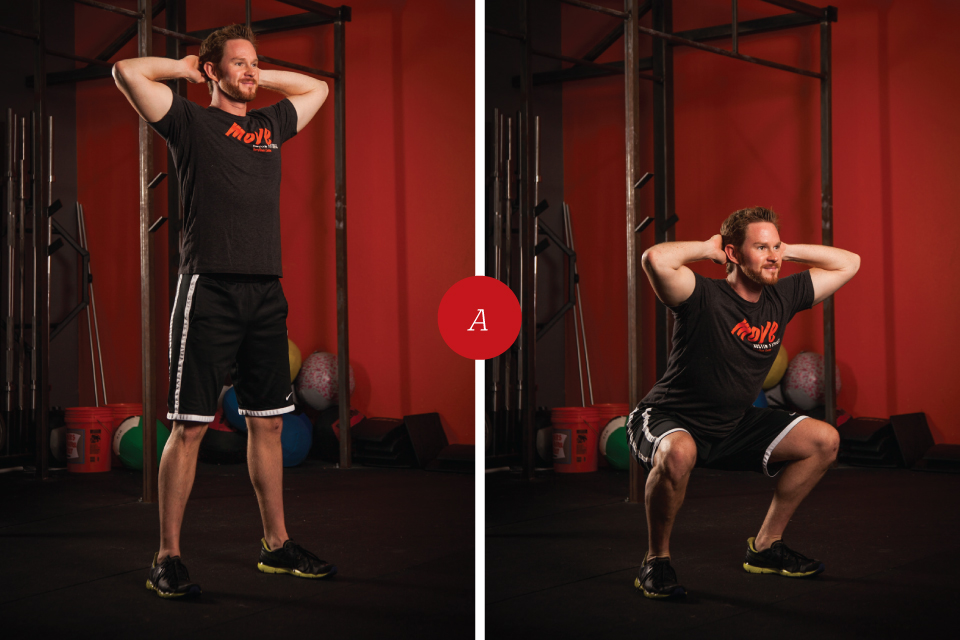Blast Off with Powerful Legs

Here is a circuit that is a surefire way to build overall work capacity (more work in less time) and a stronger, more enduring lower body. It’s a great complement to any type of training you may be doing currently and can be used as a metabolic “booster” for your overall program. It can even be a measuring tool to see where your current overall conditioning level is over time by experiencing how each phase of the circuit becomes easier or harder. What does increasing this kind of work capacity mean to you? Well, if you are running, it means better strength endurance, which boosts running performance. If you are targeting weight loss, the more work you can do in less time allows you to accomplish more within a training session, again boosting energy expenditure. Furthermore, if you are a busy person or one who travels often, this can be a great tool for getting some strength and conditioning with no equipment needed.
“Super legs,” as this circuit was originally called by world-renowned strength coach Vern Gambetta, is something that I have put into my training repertoire for over ten years. You’ll notice the circuit combines both strength and power endurance, both of which will positively affect your conditioning level. Like any new exercise or circuit, progression is the key to success. Research supports the concept that it is not necessary to train to failure or experience severe muscle soreness in order to see results (although many training cultures hold a contrary belief). Conditioning with this type of compound circuit (four sets of four different exercises) can be quite intense and definitely warrants following a volume progression in order to build safely while achieving the best results.
Before we introduce the circuit, let’s talk about how we are going to progress the circuit safely. In the box below, a letter identifies each exercise (for example, A=Speed Squats with High Arm Position); proper progression of the circuit is broken down by phases, each of which lasts for two weeks before moving to the next level.
BLAST OFF WITH POWER LEGS VIDEO
Phase One:
1. A (rest) B (rest) C (rest) D (rest) = one complete set
2. Complete three sets once a week for two weeks
(Rest 30-60 seconds between exercises, and 1-2 minutes between complete sets)
Phase Two:
1. A + B (rest) C + D (rest)= one complete set
2. Complete three sets once a week for two weeks
(Rest 30-60 seconds between exercises and 1-2 minutes between complete sets)
Phase Three:
1. A + B + C + D = one complete set
2. Complete three sets once a week for two weeks
(Rest 1-2 minutes between complete sets)
Phase Four:
1. A + B + C + D = one complete set
2. Complete four sets once a week for two weeks
(Try to complete each set in 90 seconds or less and rest for 1-2 minutes between complete sets)
A) Speed Squats with High Arm Position (20 repetitions)
- Start standing tall with fingers behind the ears, elbows straight out to the side, and feet shoulder-width apart.
- Keeping arm position, sit back into a squat until thighs are parallel with the ground (chest is out and eyes are forward).
-
Perform repetitions as fast as you can control while maintaining proper form

B) Alternating Lunges (20 repetitions)
- Start standing tall with hands in same high arm position and feet hip-width apart.
- Step out into a lunge while maintaining a vertical torso. Then push back from your heel.
- Repeat on the opposite side.
- Again, perform repetitions as fast as you can control while maintaining proper form
C) Box Shuffles (20 repetitions)
-
Using a 6-12” box or step, start with one foot completely on the box in a flat position.

- Lean slightly over the front edge of the box, loading the foot resting on the box.
- Push though the box—be sure to get full extension of the ankle, knee, and hip—and then switch feet in the air.
- With the opposite foot completely on the box, repeat on the other side.
- Again, perform repetitions as fast as you can control while maintaining proper form.
- If you do not have a box or step available, replace this exercise with split jumps or scissor jumps.
D) Squat Jumps (10 repetitions)
- Start standing tall with fingers behind the ears, elbows straight out to the side, and feet shoulder-width apart.
- Quickly (but with control), squat to parallel and then push through the floor to perform a jump.
- You do not need to get high off the ground, but legs should be fully extended.
- Control each jump. Be sure to land softly and quietly.
- NOTE: This last exercise requires only half the repetitions of the others because of the intensity of the movement!

So there you have it—a super boosting circuit to supplement your existing program and help you achieve that extra edge for performance and training results






